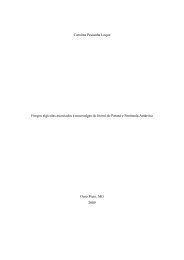Species richness in Madeiran land snails, and its causes
Species richness in Madeiran land snails, and its causes
Species richness in Madeiran land snails, and its causes
Create successful ePaper yourself
Turn your PDF publications into a flip-book with our unique Google optimized e-Paper software.
L. M. Cook<br />
Figure 1 The <strong>Madeiran</strong> archipelago.<br />
The ma<strong>in</strong> early author of <strong>Madeiran</strong> mollusc taxonomy was<br />
Lowe (1854 <strong>and</strong> earlier), <strong>and</strong> there has been a thorough review<br />
by Waldén (1983). Cameron et al. (2006) refer to other recent<br />
taxonomic work, which pre-dates the revisions of Bank et al.<br />
(2002). The taxa recognized are morphospecies, usually based<br />
on shell characters, sometimes with anatomical descriptions.<br />
The 19th century descriptions have been supported by later<br />
work, <strong>and</strong> the species-level systematics is relatively stable.<br />
Wollaston (1878) was the first to discuss distribution on the<br />
is<strong>l<strong>and</strong></strong>s <strong>in</strong> detail, <strong>and</strong> this was later exam<strong>in</strong>ed by Waldén<br />
(1984).<br />
We recorded 117 extant endemic <strong>and</strong> 36 non-endemic<br />
species <strong>in</strong> our surveys. On Madeira, 24 endemics were<br />
restricted to the west, south <strong>and</strong> east coasts, 23 to up<strong>l<strong>and</strong></strong><br />
forest. On Porto Santo, n<strong>in</strong>e endemic species were found only<br />
<strong>in</strong> the west, 15 only <strong>in</strong> the east, <strong>and</strong> 20 were distributed more<br />
broadly. There are 25 endemic species on the Desertas, 10<br />
restricted to that group <strong>and</strong> 11 on only one of the is<strong>l<strong>and</strong></strong>s.<br />
<strong>Species</strong> encountered only as fossils br<strong>in</strong>g the totals to 141<br />
endemics <strong>and</strong> 37 non-endemics, 178 <strong>in</strong> total (see Appendix S1<br />
<strong>in</strong> Supplementary Material). Almost all non-endemic species<br />
are European, <strong>in</strong>troduced s<strong>in</strong>ce human colonization <strong>in</strong> the<br />
15th century, <strong>and</strong> mostly on Madeira.<br />
The number of species collected <strong>in</strong> different parts of the<br />
archipelago is shown <strong>in</strong> Table 1. Small islets all have reduced<br />
faunas. Numbers of endemics <strong>in</strong> other sections vary from 12 <strong>in</strong><br />
the s<strong>and</strong>y northern part of Porto Santo to 27 <strong>in</strong> <strong>Madeiran</strong><br />
section D, where forest comes down to the coast <strong>and</strong> up<strong>l<strong>and</strong></strong><br />
species feed <strong>in</strong>to the fauna com<strong>in</strong>g from coastal regions to east<br />
<strong>and</strong> west. More homogeneous sections have between 14 <strong>and</strong> 23<br />
species. Section B is the eastern pen<strong>in</strong>sula. It is small <strong>in</strong> area,<br />
quite low-ly<strong>in</strong>g <strong>and</strong> dry, but with some forest species, probably<br />
relicts from an earlier, damper phase (Goodfriend et al., 1996).<br />
It is impossible to know whether any rare species have been<br />
overlooked, but the surveys have been thorough enough to<br />
provide substantially correct lists for the different sections.<br />
Despite the high count for the whole is<strong>l<strong>and</strong></strong> group, the average<br />
number of species <strong>in</strong> <strong>in</strong>dividual regions is not large compared<br />
Table 1 Numbers of <strong>l<strong>and</strong></strong> snail species <strong>in</strong> identified subsections of<br />
the <strong>Madeiran</strong> is<strong>l<strong>and</strong></strong>s.<br />
Location<br />
Total<br />
species<br />
Mean per<br />
sample<br />
Total<br />
endemics<br />
Madeira<br />
A 32 18.8 19 5<br />
B 22 12.3 14 3<br />
I 38 13.7 19 11<br />
H 39 15.1 26 9<br />
C 30 13.1 17 9<br />
D 41 25.7 27 3<br />
E disturbed wood 36 12.2 21 12<br />
F wood > 600 m 29 14.3 19 8<br />
G wood > 900 m 35 10.1 23 14<br />
Deserta Is<strong>l<strong>and</strong></strong>s<br />
Ilhéu Chão 9 8.2 9 4<br />
Deserta Gr<strong>and</strong>e 25 7.2 14 10<br />
Bugio 22 8.0 11 4<br />
Porto Santo<br />
Ilhéu de Ferro 15 13.0 13 2<br />
Ilhéu de Baixo 15 12.5 13 2<br />
West 32 10.1 28 15<br />
North 16 8.3 12 7<br />
East 40 13.1 32 34<br />
Ilhéu de Cima 15 11.3 13 3<br />
Ilhéu das Cenouras 9 9.0 7 1<br />
Ilhéu de Fora 9 9.0 8 1<br />
No.<br />
samples<br />
Madeira: letters refer to divisions <strong>in</strong> Fig. 3 <strong>and</strong> tables <strong>in</strong> Cameron<br />
& Cook, 2001;. Desertas: Cameron & Cook (1999a) 19th century<br />
totals. Porto Santo: Cameron et al. (1996b). More samples are<br />
available for many of these areas; those shown were collected under<br />
comparable conditions.<br />
with other is<strong>l<strong>and</strong></strong>s or cont<strong>in</strong>ental areas, <strong>in</strong>clud<strong>in</strong>g western<br />
Europe (Solem, 1984; De W<strong>in</strong>ter & Gittenberger, 1998;<br />
Cameron et al., 2003; Nekola, 2005).<br />
The faunas of the is<strong>l<strong>and</strong></strong> groups are dist<strong>in</strong>ct. In our surveys,<br />
Madeira (with 62) <strong>and</strong> Porto Santo (with 47) have only three<br />
species <strong>in</strong> common. Vertig<strong>in</strong>idae <strong>and</strong> Vitr<strong>in</strong>idae are today only<br />
on Madeira. Three helicid genera are only on Porto Santo.<br />
Leiostyla (Pupillidae) has 20 species on Madeira, seven on<br />
Porto Santo <strong>and</strong> two on the Desertas. In the helicid genus<br />
Discula, there are two species on Madeira, 15 (<strong>in</strong>clud<strong>in</strong>g<br />
ext<strong>in</strong>ct) on Porto Santo, <strong>and</strong> three on the Desertas. Among<br />
fossil endemics, Craspedopoma mucronatum (Mencke),<br />
Heterostoma paupercula (Lowe) <strong>and</strong> Caseolus punctulatus<br />
(Sowerby) are common to all three groups. Craspedopoma<br />
mucronatum is now limited to Madeira. Caseolus punctulatus is<br />
no longer on Madeira, where H. paupercula is largely restricted<br />
to the eastern parts <strong>in</strong> conditions like those widespread on<br />
Porto Santo. The high forests <strong>in</strong> Madeira are the centres for<br />
Vertig<strong>in</strong>idae, Vitr<strong>in</strong>idae <strong>and</strong> Pupillidae. On Porto Santo, there<br />
are eastern <strong>and</strong> western faunal group<strong>in</strong>gs that show up<br />
when data from sample sites are clustered (Fig. 2). On<br />
Madeira, cluster<strong>in</strong>g <strong>in</strong>dicates at least four coastal regions with<br />
different faunal compositions (Fig. 3), some species show<strong>in</strong>g<br />
648 Journal of Biogeography 35, 647–653<br />
ª 2007 The Authors. Journal compilation ª 2007 Blackwell Publish<strong>in</strong>g Ltd




